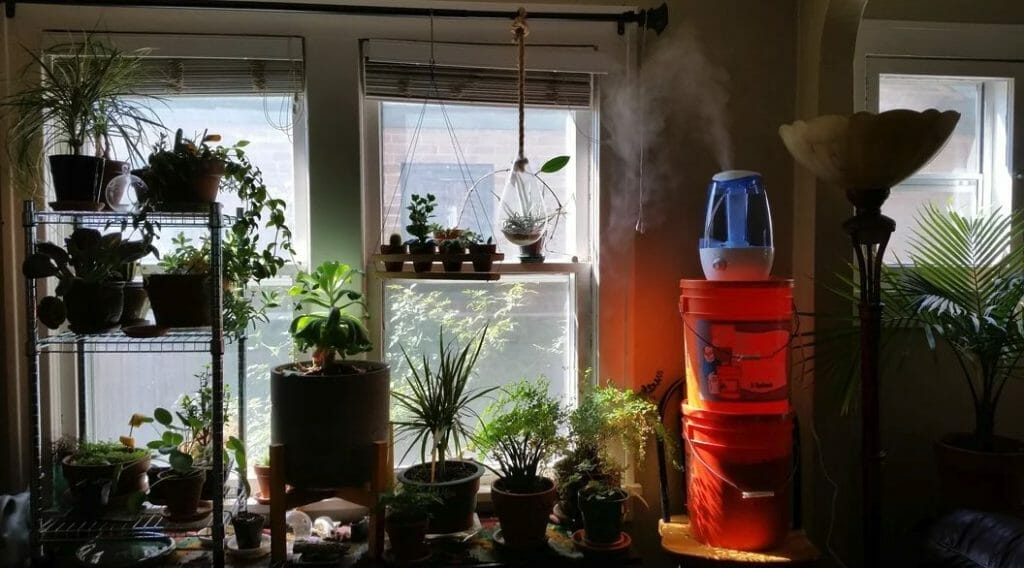Where To Place Humidifier For Plants – Find The Perfect Spot

Plants require specific environmental conditions to thrive; one crucial factor is humidity. While some plants can tolerate low humidity levels, others need a more tropical environment to flourish. This is where a plant humidifier comes in handy. In this blog post, we will explore the best locations to place your air humidifier for plants, ensuring optimal growth and health.
Understanding the Importance of Humidity for Plants
Before we delve into the placement of plant humidifiers, let’s briefly discuss why humidity is essential for plants. Humidity affects the rate plants transpire or lose moisture through their leaves. Maintaining an appropriate humidity level helps plants maintain their vital moisture balance, preventing them from drying out and suffering stress.
Factors to Consider When Placing a Plant Humidifier
While it may seem simple to place a humidifier near your plants, there are several factors you should take into account to ensure the best results:
Plant Requirements
Different plant species have varying humidity preferences. Some plants, like ferns and orchids, thrive in high-humidity environments, while others, such as succulents, prefer drier conditions. Understanding your specific plant’s needs will guide you in finding the ideal location for your humidifier.
Room Size
The size of the room where your plants are located plays a crucial role in determining where to place your humidifier. Larger rooms may require multiple humidifiers strategically positioned to ensure even humidity distribution.
Airflow and Ventilation
Consider the airflow and ventilation in the room. Avoid placing the humidifier near vents or fans, as this can disperse the moisture too quickly, leading to uneven humidity levels.
Proximity to Plants
While placing the humidifier right next to your plants may be tempting, it’s important to strike a balance. Positioning the humidifier too close can result in oversaturation, potentially causing water damage or promoting mold growth. Aim for a location that provides sufficient coverage without directly saturating your plants.
Humidifier Type
Different types of humidifiers have varying ranges and methods of dispersing moisture. Choosing the right type of humidifier for your plants and considering its range and output capacity when determining its placement is essential.
Ideal Locations for Plant Humidifiers
Now that we’ve considered important factors, let’s explore some ideal locations for placing your plant humidifier:
Near Your Plants
While we mentioned earlier that proximity to plants should be balanced, placing the humidifier within a reasonable distance can help ensure the plants receive adequate moisture. Position it on a nearby table or shelf, ensuring it is not directly blowing onto the foliage.
Near a Window
If your plants are near a window, placing the humidifier nearby can create a microclimate that mimics natural conditions. The slight breeze from an open window and the gentle mist from the humidifier can provide an optimal environment for your plants.
Opposite Air Vents or Fans
Positioning the humidifier opposite these vents or fans can help counterbalance their drying effects if you have forced-air heating or cooling systems in your home. This allows the moist air from the humidifier to offset the dryness caused by the air circulation.
Central Location
Placing the humidifier in a central location for larger rooms or greenhouses can help distribute moisture evenly throughout the space. This ensures that all plants receive a similar humidity level, regardless of their proximity to the device.
Within an Enclosure
If you have specific plants that require high humidity levels, such as tropical varieties or terrariums, consider creating an enclosure with plastic sheeting or glass. Place the humidifier inside this enclosure to create a controlled environment with optimal humidity for these plants.
Monitoring and Adjusting Humidity Levels
Once you have set up your plant humidifier in an ideal location, it’s important to monitor and adjust humidity levels as needed regularly. Here are a few tips:
Hygrometer
Invest in a hygrometer to accurately measure the humidity levels in your plant’s environment. This device will help you determine if adjustments need to be made.
Trial and Error
Finding the perfect balance of humidity may require some trial and error. Monitor your plants closely and make adjustments based on their response to the humidity levels provided by the humidifier.
Regular Maintenance
Regularly clean and maintain your humidifier to prevent bacteria or mold growth that could harm your plants. Follow the manufacturer’s instructions for cleaning and replacing filters as needed.
Conclusion
Placing a plant humidifier in the right location is crucial for creating an optimal environment for your plant’s growth and health. Consider plant requirements, room size, airflow, and proximity when determining where to place your humidifier. Experiment with different locations and regularly monitor humidity levels to ensure your plants thrive in their ideal conditions. With proper care and attention, your plants will thank you with lush foliage and vibrant blooms.







